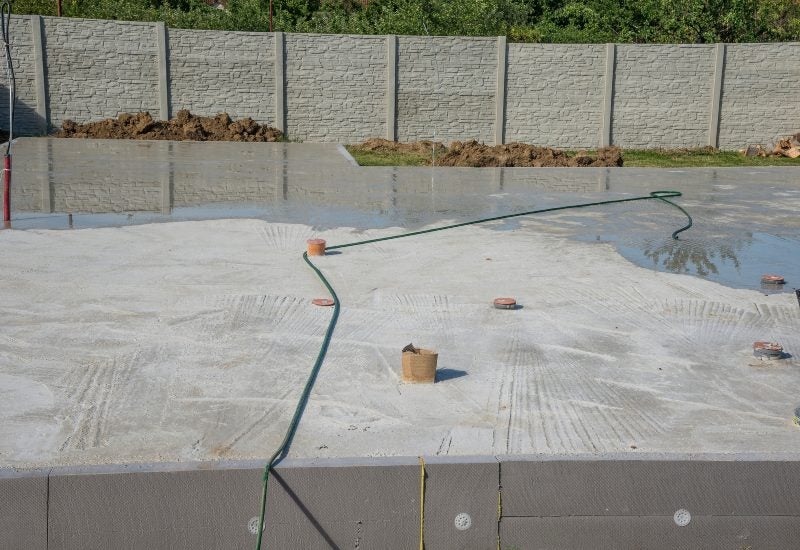Concrete Resurfacing by Triad Basement Waterproofing
As a proud homeowner, you strive to care for your property, so it always looks and functions its best. As you assess the structures and features around your home and yard, one thing that might stick out is the old, cracked concrete. You may not be eager to pay for a replacement, but this eyesore is starting to wear on you.
That’s where concrete resurfacing comes in. This restoration technique revives worn or damaged concrete surfaces without completely replacing them. It’s a cost-effective solution that involves applying a thin layer of concrete overlay or coating to existing concrete, enhancing its appearance, durability, and functionality. Suitable for basements, driveways, patios, and sidewalks, concrete resurfacing offers a sustainable way to extend the lifespan and improve the appearance of concrete surfaces throughout your property.
Why is Concrete Resurfacing Necessary?

Concrete is subject to wear and tear over time due to foot traffic, weather, and other environmental factors, leading to cracks, stains, and a worn-out appearance. Concrete resurfacing solves these issues, providing a fresh top layer that makes the concrete look brand-new without the cost of a full replacement. You can even use this opportunity to customize the concrete’s color, texture, and pattern, creating the look of a completely new slab and improving your property’s aesthetics.
What is the Procedure for Concrete Resurfacing?
Whether you’re looking to resurface basement concrete or a concrete patio, the process is largely the same. Here are the key steps involved to ensure a successful application:
- Initial inspection and repair: The first step is to assess the concrete surface for any major damage. Repair cracks or holes larger than one-quarter inch deep or wide to ensure a smooth, structurally sound base for resurfacing.
- Cleaning: Thoroughly clean the surface using acid, detergent, or bleach, followed by pressure washing to remove any deteriorated concrete and ensure overlay adhesion.
- Preparation of the resurfacer: Mix the concrete resurfacer with water using a commercial-grade drill and mixer. A mechanical mortar mixer may be needed for later jobs. Follow the manufacturer’s instructions to achieve the correct consistency.
- Application: Apply the resurfacer in one-foot-wide strips using a long-handled squeegee. Work the product into the surface to ensure it penetrates the pores and achieves an even thickness.
- Finishing touches: After the resurfacer begins to set, use a broom to texture the surface for a non-slip finish if desired. Keep the surface moist for 24 to 48 hours to promote a strong bond and prevent shrinkage cracks.
What are the Advantages of Concrete Resurfacing?
Concrete floor or driveway resurfacing offers numerous benefits:
- Cost-effectiveness: Resurfacing eliminates the need to demolish and replace existing concrete, saving money on labor and materials.
- Quick turnaround time: The resurfacing process is much faster than laying new concrete, with areas often ready for traffic in just a few days.
- Customizable finishes: Even without a full replacement, you still have the flexibility to choose a new finish with coloring, stamping, or staining, making it easy to match any decor or landscaping theme.
- Durability: Resurfacing adds a strong top layer to the existing concrete, extending its lifespan and enhancing resistance to wear and tear.
- Low maintenance: The new surface requires minimal upkeep, saving time and money on future maintenance and repairs.
Does My Surface Qualify for Concrete Resurfacing?
Concrete resurfacing works best on areas with minor damage, so a thorough evaluation is required to determine if a surface is suitable for this restoration method. Excessive cracking is a concern because it might suggest deeper issues like ground movement, potentially causing the resurfaced layer to crack. Dusting and high moisture levels may also compromise the resurfacing process, leading to delamination or damage.
It’s important to note that resurfacing doesn’t solve structural problems, so replacing the concrete might be recommended in some cases. Even if your surface qualifies for concrete resurfacing, proper preparation and repair of large holes and pitting are essential for a successful finished product.
Contact Triad Basement Waterproofing in Gaithersburg, MD
At Triad Basement Waterproofing, we pride ourselves on delivering state-of-the-art, cost-effective concrete resurfacing and basement waterproofing solutions. Our local, family-owned business has been serving Gaithersburg, MD, since 1987. We are licensed, bonded, and insured professionals who provide the highest quality work with industry-leading warranties to back up everything we do. If you’re looking for concrete floor resurfacing inside or outside your home, please contact us at (301) 532-7903 to request a free estimate.
